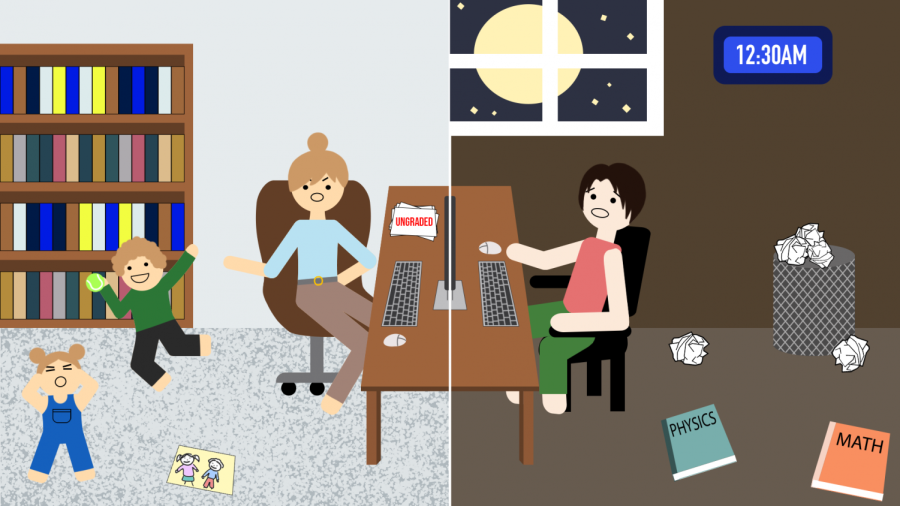Remote learning tests student and teacher patience
Graphic illustration by Diana Kohr and Elizabeth Park
All teachers and students must remember that the challenges they face are not all that different and that patience for each other is essential during this time.
October 7, 2020
Bloodshot, bleary eyes.
Screaming children in the background.
Faulty internet and bandwidth overloads.
Mountains of homework. Mountains of work to grade.
Patience levels tested to the verge of exhaustion.
This is the reality of remote school for both teachers and students.
For many teachers and students accustomed to in-person education, remote learning has been a nightmare, compounding technological, familial and personal issues. These new complications have caused more stress and confusion than ever, and patience levels are running low.
Some of these issues were anticipated at the beginning of the school year. In the online etiquette learning module that students watched, Jeff Rosado, assistant principal of school climate, emphasized the importance of student patience.
“I just want to remind everybody to really think about the hard work your teachers are putting in,” Rosado said. “This is new for all of us. Teachers now have to deliver rigorous, interesting, engaging content in this online world, and it may not always happen. Please give them the benefit of the doubt, knowing that we’re all really trying to make the best of this difficult situation that we’ve been given.”
Teachers are responsible for four to six periods, just as students have a variety of classes in their schedule. Unfortunately, this similarity is sometimes overlooked during student-teacher communication. When considering the other party, students and teachers often forget about the workload on both ends from classes beyond the ones that they share. Students may find it easier to remember exactly what their teachers did or did not cover during class, but teachers who teach multiple periods of the same class may have covered material at different speeds in different periods. Likewise, teachers who have similar assignment policies for their classes know their assignments and due dates well. However, for students who have an abundance of tasks with varying due dates and times from completely different classes, it is often difficult to keep track of assignments.
On top of this, when the district made the official decision to shift to Schoology as its learning management system, no one could have foreseen the shelter-in-place order and subsequent school shutdown. Moving to Schoology was a big transition, and it certainly was not smooth sailing for all parties involved. Getting used to a new learning platform is never easy, but it is especially difficult during distance learning, without in-person access to school technicians.
“In the situation that we’re in right now, Schoology does the job,” junior Janani Asokumar said. “But if this were a normal year, I’d like a learning management system where grades are the first thing that you see when you open it. In Schoology, you have to dig around to find grades, and there are some classes, like guidance, that aren’t necessarily part of your core classes. It could be hard to navigate.”
While students were given a week to complete learning modules that explore and introduce Schoology, a majority of teachers had to master a more complicated Schoology teacher interface during the summer, before the first semester began. Even after seven weeks of school, Schoology is still a relatively new platform, so errors on both ends are to be expected and should be addressed without apportioning blame.
Getting accustomed to Schoology is only one of many common technical difficulties. With so many people using the internet, other issues, such as slow internet connection, Zoom crashing and microphone and camera problems, have arisen. There are endless possibilities to these technical difficulties, and the likelihood of them happening is inevitable.
Although many students have the notion that teachers should be flexible and able to teach in any learning environment, teachers suffer from the same technical issues that students do. Knowing that slow internet could affect an entire class of students only adds to the pressure.
“In the first week of school, my computer crashed and my Zoom wouldn’t let me in,” English teacher Connie Willson said. “I felt a whole lot of panic, so when my students tell me they’ve had technology problems like that, I understand.”
As such, students should be patient if teachers are facing technical difficulties during class. At the same time, teachers should also recognize that these setbacks often take up class time, further increasing screen time by giving students more work to do after school. They should remain flexible about deadlines for students making up missed work due to technical difficulties. In addition, students may feel overwhelmed with the faster paced teaching that some teachers are using to compensate for reduced hours in class.
On the other hand, even though technical difficulties on a student’s end may not affect the entire class, teachers should still be flexible with making up missed work due to these shared difficulties.
Not only have teachers had to adjust their curriculums to fit remote learning, but teachers with more hands-on classes, such as art, PE and band, have had to completely rethink their classes. They must consider the different resources students have, as well as their different situations. Compared to in-person learning, when participating in hands-on classes was relatively simple, students now have to use the resources they have at hand and adjust according to the teacher’s guidance. In July, teachers of hands-on classes were able to restructure their emergency distance learning class to better suit current remote school.
Some changes hands-on teachers have made to better adjust their classes are providing students the art materials needed at the beginning of the school year. This allows all students to have access to the same mediums, so grading is more fair. PE teachers have created their own workouts, which they go through during class. Students’ video must also be on whenever possible, so more accurate participation credit can be given. However, not all hands-on classes are viable online. In particular, band classes are having an especially hard time playing instruments together, due to lag and sound limitations.
Use of online resources was common even during in-person school, but teaching, posting assignments and grading purely online is completely new and requires teachers to be much more reliant on technology. Individual work on a device can already be difficult for some, but trying to engage and form real relationships with students is undoubtedly harder. The transformation of the classroom environment in which students were present and engaged to small digital boxes, often containing disinterested, muted students, has made it more demanding for teachers to be interactive.
On the other hand, students find it challenging to gauge the teacher and their teaching style, making some reluctant to ask questions. Students may also feel awkward when trying to participate in class, as being the only unmuted student can be much more intimidating than raising your hand in an in-person class. Even when students are willing to participate, visual cues are tougher to recognize through a screen compared to physical hand-raising, making it rather burdensome to ask questions or make comments. Eventually, these factors could reflect negatively in a student’s participation grade.
“It’s kind of awkward talking to [the teachers],” sophomore Patricia Chang said. “Because I haven’t met them in real life, I don’t really know what offends them. So it’s hard to talk about how their homework affects me.”
Furthermore, work and family life are no longer the distinct elements that they used to be. Working from home, while being stuck inside with family members, is not an easy situation. Some teachers with younger children face constant disruption, which significantly impacts work efficiency. Even without young children to care for, spending more time at home means that more home care must be done. While students may not have the same familial responsibilities as teachers, outside disturbances are common and include nagging parents, loud neighbors and construction. Background noise interference affects both students and teachers, and is sometimes severe enough to interrupt synchronous learning.
“It’s been really difficult because younger kids need a lot of attention, direction and reminders to stay focused,” Chemistry teacher Connie Leung said. “But multitasking has been helpful, sometimes I’ll be grading on my phone while trying to put the baby to sleep.”
Despite individual struggles, students must communicate with teachers regarding the impact of distance learning as well as specific classes on their lives, so that teachers can use this feedback to better adjust their class structure. This way, both parties recognize their many common struggles and come to terms with the fact that patience, like trust, is a two-way street. Teachers and students must treat each other with equal respect and consideration, as they are facing similar, yet slightly different, challenges.
“There’s that constant anxiety and worry of, ‘I’m not doing my best work, and I don’t know the students as well,’” English teacher Jane Gilmore said. “But you can’t let that get you down, you can’t let that stop you from trying. You just have to find new ways and [see] the upsides.”





























































